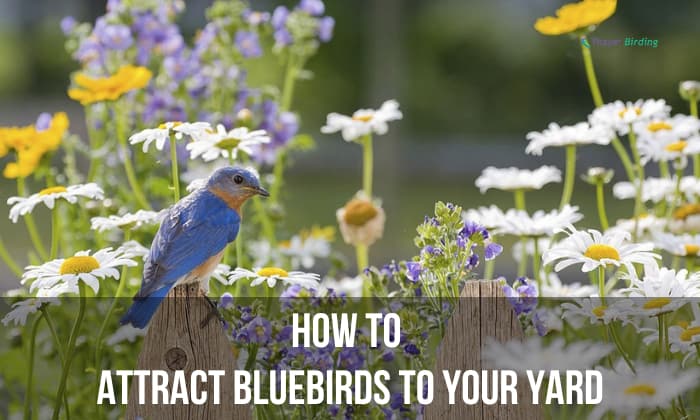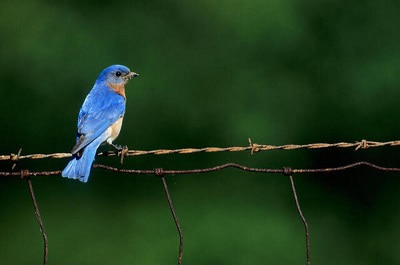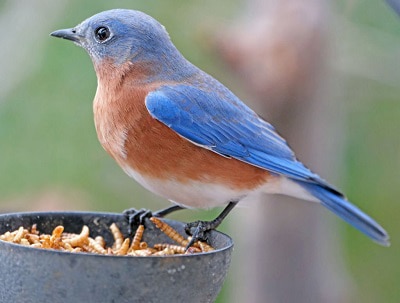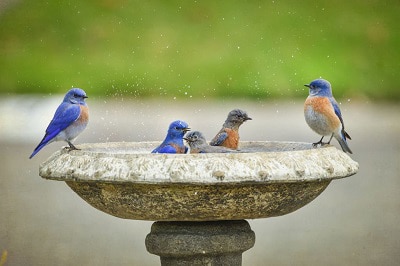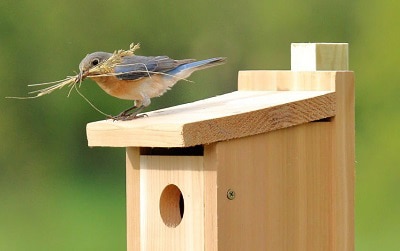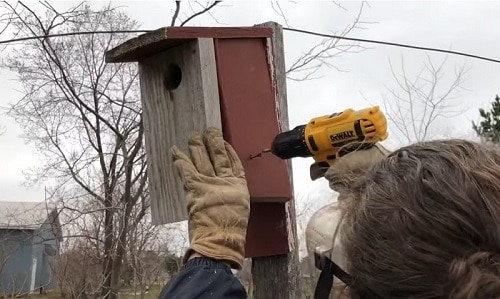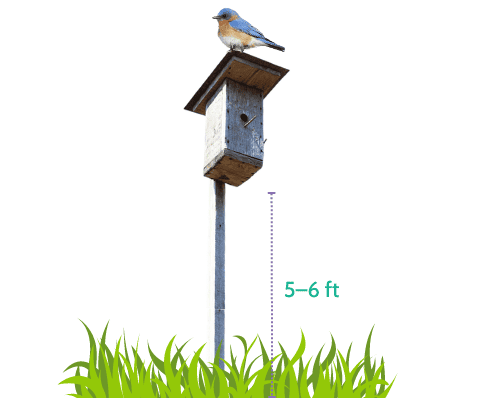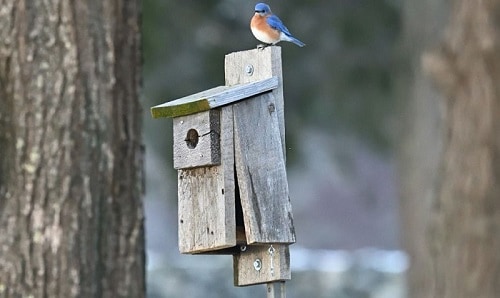Birds are lovely to have in your yard, but bluebirds, in particular, are special because of their bright color and cheerful song.
If you don’t have any bluebird visitors, don’t worry–it isn’t too difficult to figure out how to attract bluebirds to your yard.
You can attract these birds by creating a bluebird-friendly habitat with open spaces and a gurgling water bath, designing your nest box well, and planting native berry bushes and trees.
Read on to learn each tip’s particulars and how to solve common problems!
Table of Contents
Ways to Attract Bluebirds to Your Yard
You can attract three possible bluebirds depending on where you live in America.
- Eastern bluebirds live across the central and southeast of the United States.
- Mountain bluebirds live in higher altitude areas across the entire western and central North America, from Canada to Mexico all the way to Alaska.
- Western bluebirds are found along the western coastlines of the United States and down toward the southwestern region of the American continent.
Despite slight differences, all three species have bright blue backs and pale orangey undersides.
Aside from their splash of colorful and cheerful singing, they are welcomed by homeowners because they are insectivores that help keep bug populations at bay!
How can you attract eastern bluebirds to your yard? Read on for several tips!
Creating a Bluebird-friendly Habitat
If you want bluebirds to visit you, you must make your garden as welcoming as possible. Below are some suggestions to make your yard more appealing.
1. Have lots of open space
Bluebirds love open spaces–the ideal eastern bluebird habitat should only have a few trees and bushes.
Additionally, bluebirds are ground feeders who love pecking the ground for grasshoppers, crickets, spiders, and caterpillars. Keep your grass trimmed to help them quickly spot and hunt their favorite bugs!
2. Give them a hunting perch
Bluebirds eat on the ground but need a slightly higher view to spot their prey more quickly.
Install a 3-4 inch tall perch where bluebirds can sit and scan for food.
Your perch can be a simple T-shaped wooden pole, and they will also happily sit on fence posts and wire fences.
3. Tempt them with their favorite foods
Would you enter a restaurant with a cart out front offering free samples of some of their best sellers? The answer is likely yes!
Bluebirds are the same. Offer them their favorite food in a feeder, and over time, they will come to associate your yard with good food and visit regularly.
They will fly to mealworms that are juicy and live–not dried ones. This distinction is crucial for bluebird chicks, who get a lot of hydration from the worms.
You can also leave out seeds, such as hulled sunflower seeds, and crumbled or shredded suet balls to blue feeders, though these might attract many other bird species.
Note that bluebirds like to eat from platform feeders or open dishes instead of standard bird seed feeders. However, you can also make one with a tuna can and a nail!
Lastly, to get birds to fly to a feeder, it must be installed in the right place. Do not install it too close to nesting boxes since that may give predators access to the bird eggs or chicks!
4. Install a bird bath
Aside from food to feed bluebirds, birds need water to drink and bathe in. Therefore, an excellent way to entice feathery friends over is to install a bird bath, ideally with a fountain.
However, ensure to install a relatively big bird bath, enough for about a dozen birds, since this species likes to bathe together! Don’t forget to clean the bird bath on a regular basis to keep the water fresh.
Also, during the colder months, make sure that the bird bath has a heater installed at its bottom to prevent freezing.
5. Leave out nesting materials in the yard
Bluebirds will appreciate help in finding their nest materials. Leave out pine needles, cotton scraps, twigs, small sticks, and other natural, organic matter that can make a comfortable home for chicks.
6. Design Your Nest Box For Bluebird Use
Bluebirds are cavity nesters—birds that live in an existing hollowed-out area. They are different from woodpeckers, for example, who create their own holes for nests.
While bluebirds prefer living in hollow trees, they will just as happily live in human-made dwellings such as nest boxes.
- Nest Box Design
The North American Bluebird Society and other experts recommend the following dimensions for bluebird nest boxes:
-
- Made of thick cedar wood or plastic, ideally 3/4″ thick.
- Have a roof overhang of 2 1/2″
- Floor size of 5×5 or 6×6 inches.
- A 5” drop (distance from the bottom of the entry hole to the nest box floor).
- An entry hole diameter of 5 inches. While round holes work fine, some scientists have observed the positive effects of oval entry holes for bluebird nest boxes!
- No perch Bluebirds do not need the perch. Not to mention that it may help predators sneak in instead!
Meanwhile, they also recommend up-drilled air vents, brass hinges, predator guards, and an elevator mesh floor to protect chicks from flies.
While you can build a bluebird house on your own, many ready-to-use ones are available.
- Nest Box Placement
The nest box should face southeast or east, where your bluebirds can get a lot of healthy morning sun. This direction will also protect them from strong winds and the harsh afternoon sun.
The box should also be 5–6 feet off the ground. Consider mounting it on a prefabricated or metal pole, which is much harder for other animals to climb.
- Keep it clean and safe
Bluebirds can have multiple broods in a single season. For your visitors’ hygiene, clean after each brood leaves. This means cleaning your box 3–4 times a year.
Also, consider installing baffles, such as cone- or dome-shaped ones, to keep away squirrels, raccoons, and other animals trying to snack on your birds’ meals.
Lastly, if you have the space, consider a bigger roost box that can house up to a dozen birds. Wintering birds like to huddle together for warmth and protection!
Other Methods to Attract Bluebirds Naturally
Here are a few more things you can add to your garden to invite bluebirds.
1. Plant native berry and fruit trees
While bluebirds eat plenty of bugs in the spring and summer, their diet switches to berries and fruit in the wintertime. Therefore, berry bushes and trees are guaranteed plants that attract bluebirds.
To ensure your plants thrive and live longer, it’s best to plant foliage native to your area. If possible, try planting flowering dogwood, foster holly, and eastern red cedar—bluebirds’ favorite berry trees.
2. Leave dead trees in your yard
As mentioned, bluebirds live in cavities. Whether these are artificial or natural is of no importance to them.
Leave mature or dead trees and branches in your yard. These will give your guests additional lodging options.
3. Avoid using insecticides
Last but not least, avoid using insecticides in your yard.
Don’t worry about your garden being overrun by bugs: If the worms are healthy, chances are high that bluebirds will come and happily gobble them up for you!
Fix Common Problems
There are three possible reasons bluebirds are not coming to your yard.
1. They need more time
One possible problem is time. If you have just started applying all the tips listed above, bluebirds may need several more weeks to detect your garden. Be patient.
2. Invasive species
Aggressive house sparrows often run over nest boxes, sometimes killing bluebirds already nesting inside.
To ensure this doesn’t happen, check your nesting box at least once a week and remove any sparrow nesting material.
3. Predators
Cats, snakes, raccoons, and more threaten Bluebirds. Installing a baffle on your feeder is a simple way to keep them from reaching your feathery guests as they eat.
And when cleaning your nest box, throw the nest away far from the nesting box. This prevents predators from associating your area with eggs and birds.
Frequently Asked Questions
What do bluebirds eat?
It depends on the season. For most of the year, bluebirds thrive on bugs and worms freshly picked from homeowners’ yards. In winter, though, these birds swap to berries and fruits.
When is the best time to put up a birdhouse for bluebirds?
Anytime! Bluebirds will fly to a bluebird house year-round.
If you prefer not to, it’s best to set them up in early spring, before the breeding season starts. Having them ready by January or February allows bird couples time to build their nests in time for egg laying.
Assuming you are preparing for winter, it’s best to set it up in the early autumn to prepare for wintering birds and accommodate migrating birds.
Related: 11 Efficiently Methods to Attract Birds to a Birdhouse.
How can I protect bluebirds from predators?
Installing baffles is a straightforward way to protect bluebirds and their eggs from predators. These make it impossible for them to reach your birds.
You can also spread scents that repel cats or have your pet cat wear a brightly-colored collar.
How long does it take to raise one bluebird brood?
Raising bluebirds broods takes roughly one month.
| Nest building | 1-6 days |
| Egg laying | 5-7 days |
| Incubation | 12-14 days |
| Fledging (time before the young fly off) | 16-21 days |
Conclusion
How to attract bluebirds to your yard is a simple matter. There are many things you can do to transform your garden into a haven bluebirds can’t refuse.
However, if you’ve tried all the tips and waited for weeks without any results, perhaps it’s a matter of geography.
Luckily, there are countless beautiful birds scattered all over the world. Try to figure out which ones live near you, and shift your focus on trying to attract those instead!

George and I became friends after a birdwatching trip with our new group. And we have been enjoying every adventure together. When he told me the idea of establishing a site that shares our experiences and fun, I immediately agreed. After trials and errors, here we have Thayerbirding.


